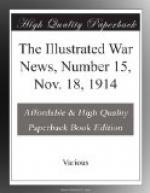The German heavy “batteries of position” are for the most part armed-with the 15 cm., or 6-inch howitzer, throwing a shell of 90 lb. with an approximate range of 6650 yards. The howitzer type of mobile heavy gun is much favoured for defensive work in both the German and the Austrian armies. The howitzer is capable of elevation up to 65 deg., the idea of this high elevation being, it is stated, to obtain a steep angle of descent for the shells at comparatively short ranges, in combination with a high remaining velocity so as to ensure the penetration of overhead cover. These howitzers are also employed in siege and fortress defence warfare. They have been used along the Aisne positions as auxiliaries to the giant Krupp siege-howitzers.
_______________________________________________________
___________________ 24—The illustrated war news, Nov. 18, 1914.
[Illustration: Charging on foot with the lance: Bengal lancers attack German trenches.—From the Painting by R. Caton Woodville. (left half)]
Cavalry engaged in the Belgian frontier battles are fighting in all sorts of ways: repeatedly, for example, as infantrymen in the trenches. On occasion, also, they have even charged on foot, with bayonet or with their lances. The Life Guards, according to a letter from the front, charged the German trenches the other day with bayonets. A squadron of French dragoons dismounted and crept through a wood on foot, surprising a German infantry company and overpowering them in close-quarter fight with lances and clubbed carbines. With
_______________________________________________________
___________________ The illustrated war news, Nov. 18, 1914—25
[Illustration: Charging on foot with the lance: Bengal lancers attack German trenches.—From the Painting by R. Caton Woodville. (right half)]
lances, also, as our illustration shows, some of our Bengal cavalry, in action on foot, on October 24, at Ramscapelle, near the Yser, recaptured the village from the Germans. Dismounting near by, they charged the enemy lance in hand, driving him from his trenches. Following up their success, they then forced their way into the village, smashing in doors and windows and storming house after house in spite of fierce resistance until, assisted by other troops, they forced the enemy out, capturing guns and many prisoners. The action was particularly notable.
_______________________________________________________
___________________ 26—The illustrated war news, Nov. 18, 1914.
[Illustration: For gallantry on the field of Honour: A French officer receives the accolade.]




